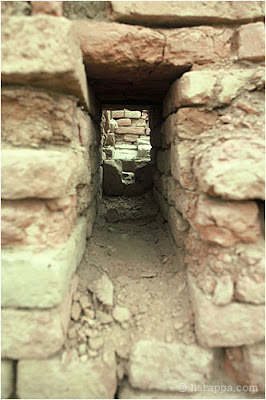
From http://www.mnsu.edu
TOWN PLAN
Mohenjo-daro, is an ancient planned city laid out on a grid of streets. An orthogonal street layout was oriented toward the north-south & east-east directions: the widest streets run north-south, straight through town; secondary streets run east-west, sometimes in a staggered direction. Secondary streets are about half the width of the main streets; smaller alleys are a third to a quarter of the width of the main streets.

Main Street

Alley
From www.harappa.com
The large platform, called the ‘Citadel’ is presumed to be the administrative seat. Other public buildings are temples and public baths. There are also granaries where the stores are elevated above brick platforms that have ventilation ducts. Separated from the domestic areas are the artisan workshops.
The street layout shows an understanding of the basic principles of traffic, with rounded corners to allow the turning of carts easily. The drains are covered. The city probably had around 35,000 residents.
The buildings were constructed of sun dried and burnt bricks. The bricks found in Mohenjo Daro and other Harappan sites are all the same size 7cm x14cm x 28cm. Sun-dried bricks were used for infill, and burnt bricks were used for the drain and sewer linings.

THE COURTYARD HOUSE
The house was planned as a series of rooms opening on to a central courtyard providing an open space inside for community activities.


From www.harappa.com
There were no openings toward the main street – only rather small openings to the side streets. . Brick stairways provided access to the upper floors or rooftop gardens. The houses are believed to have flat, timber roofs. Houses built with a perimeter wall and adjacent houses were separated by a narrow space of land. There were just a few fairly standardized layouts, perhaps an indication of a fairly egalitarian society. But not all houses had two stories and only the larger houses have their own wells. There are also rows of single-roomed barracks, perhaps for singles, soldiers or slaves.

Model of House viewed from a side street
WATER SUPPLY AND SANITATION
For water, the big houses had their own wells, other wells would serve groups of smaller.

From www.harappa.com
Almost every house had a bathroom, usually a fine sawn burnt brick pavement, often with a surrounding curb.

Waste water was directed to covered drains, which lined the major streets. First floor bathrooms also built. There is also evidence of vertical drains which were probably their toilet.

From www.harappa.com
The house drains start from the bathrooms of the houses and join up to the main sewer in the street, which was covered by brick slabs or corbelled brick arches. On the streets we can find manholes for cleaning; some drains flow to closed seeps, others flow out of the city.



Note the covered drain on the right hand side of the street!
From www.harappa.com
Mohenjo-daro was successively destroyed and rebuilt at least seven times. Each time, the new cities were built directly on top of the old ones. Flooding by the Indus is thought to have been the cause of destruction.

http://instructional1.calstatela.edu
Sources: www.ancientindia.co.uk
http://en.wikipedia.org
www.the-south-asian.com
Related Post: |
Social Bookmarking

4 comments:
Mazlin,
Fascinating history! Some of our municipal "planners" could learn a lot from these ancient people about planning sewer systems. In Panama City today 85 story towers are going up like mushrooms without a thought to a new sewer system.
1)The excavation of pashupathi seal and other seals with swastik clearly indicate that there was no aryan invasion
2)Aryan Invasion if any would have taken place the Sangam literature would have mentioned it...Sangam talks abt Kumari Kadam but is silent on Aryan invasion
3)The residents of IVC were most likely the Saraswat Bhramins,they are the only Bhramins scaterred all over india From Kashmiri pandits to the Bhramins of Karnataka,they were the people who used to reside at the saraswati river..........Saraswat bhramin can also be traced to middle east and most vivid mention of them comes as when hussian was killed a saraswat bhramin named Rahab Dutt fought for his cause and was killed and king Yazid ordered all the saraswat bhramin to be killed or chased away from middle east.....
Dear Anurag, I am aware of the controversy over whether the Aryans were original inhabitants or invaders, and your contribution is appreciated.
Dear Roberto, actually a lot of heavily populated slum areas today don't have the sanitation standards of the Harappan cities 4000 years ago.
Excelent article and fascinated cobtroversy.
Post a Comment